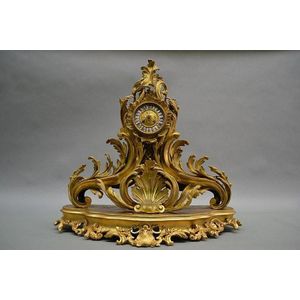Louis XV Style Brass Mantel Clock with Chapus Movement
You must be a subscriber, and be logged in to view price and dealer details.
Subscribe Now to view actual auction price for this item
When you subscribe, you have the option of setting the currency in which to display prices to $Au, $US, $NZ or Stg.
- Pendulum - The pendulum was discovered around 1602 by Galileo Galilei, and was adopted for time keeping by the Dutch mathematician and natural philosopher, Christiaan Huygens, who excelled in astronomy, physics, and horology.
The pendulum comprises a metal rod usually of brass or steel with a metal disk, known as a bob, at the end. The movement of the pendulum is driven by weights or a spring, and as a pendulum swings in a regular arc, it was found accuracy could be controlled to within a few seconds a week.
Timekeeping can be adjusted by changing the height of the bob on the rod, making the pendulum either swing slower or faster.
The disadvantage of the pendulum was that changes in temperature also changed the length of the pendulum, interfering with the accuracy of the clock, and so in the 18th century two types of mercurial pendulums were invented which countered the movement in the steel rod.
The pendulum was the world's most accurate timekeeping technology until the invention of the quartz clock, regulated by a quartz crystal, in 1927. - Movement - The technical name for the workings of a clock or watch, and does not include the dial or case.
- Foliate - Decorated with leaves or leaf-like forms.
This item has been included into following indexes:
- clocks, mantle & shelf, material or style - gilt metal / ormolu 548
- clocks, mantle & shelf, period or origin
Visually similar items

A Sevres porcelain clock, early 19th century, with movement by Leroy a Paris, having an engine turned dial with Roman numerals set within an ormolu bezel and an ornate rocaille raised and waisted mount, richly embellished with gilt highlights and handpaint

A Louis XV style ormolu mantle clock, 19th century, with maker's mark for A.D Mougin, the waisted clock lavishly cast and chased with rocaille forms, having an enamel dial with blue Roman numerals and minute markings; with key and pendulum, height 41.5 cm,

A large Louis XV style ormolu mantel clock, 19th century, with maker's cartouche for Raingo Freres to dial, an impressively cast waisted clock with enamel number cartouches to the dial surmounted by an urn above a mascaron and decorated throughout with cha

Impressive & large antique mid 19th century French gilt bronze clock in the rococo form, standing on a ornate gilt wood base
